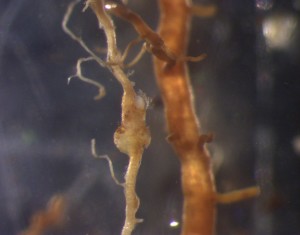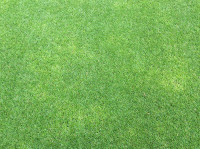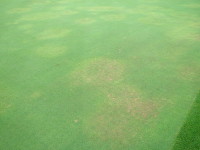Root-knot Nematodes - a notifiable nuisance!

Meloidogyne fallax (M. fallax) is a non-native, notifiable root-knot nematode that invades the roots of host plants. It has a wide host range, and can cause considerable economic damage to potato, carrot, leek and black salsify crops, in addition to sports turf. It was described from the Netherlands in 1996 and has since been reported from South Africa, Australia, New Zealand, Chile and several European countries, including Germany, Belgium, France and Switzerland.
Due to its potential to cause significant economic impact to host crops, it is essential that the risk of its introduction and spread in the UK, particularly to agricultural land, is minimised. One potential pathway to agricultural land is thought to be the disposal of turf and soil/rootzone mix when pitches are being relaid.
In the UK, M. fallax has been found in sports turf on several occasions since the first report in 2008. Since 2015, there have been three official findings on sports turf at separate locations in England and there is a risk that it could be more widespread and/or introduced to further sites in the future.
Symptoms on turf
Root feeding by M. fallax and subsequent gall formation can cause stunting, lack of vigour and yellowing of turf, reducing the quality of pitches, fields and golf courses. However, these symptoms can also be caused by another non-native, notifiable nematode, Meloidogyne chitwoodi, as well as by other species of nematode already present in the UK, including Meloidogyne minor, M. naasi, M. kralli and free-living nematodes such as Helicotylenchus pseudorobustus. Therefore, it is important to sample soil regularly and obtain an accurate diagnosis.

Biosecurity guidance
Biosecurity can be defined as a series of measures that are designed to protect against the introduction and spread of new pests, and to effectively deal with them should they arrive.
Possible pathways for the introduction of nematodes into sports turf include the soil/sand/compost used to form the growing media, ready grown-turf, machinery or footwear. Grass seed is unlikely to be infested with Meloidogyne species and so is low risk.
The risk of introducing nematodes into turf can by reduced by ensuring that:
- Growing media is nematode free
- Sand for use on sports turf is stored uncovered and weed free for at least nine months, preferably longer, before use. This is likely to kill emerging juveniles. An alternative would be to use kiln dried sand
- Compost used as part of growing media has been composted at a temperature sufficient to kill nematodes
- Footwear is cleaned before and after use on sports pitches
- Any machinery that has soil attached should be thoroughly power washed before it is moved between sites
- Waste turf, topsoil and/or sub-soil (with the exception of grass cuttings) from sports pitches, especially those where nematode damage is suspected, should not be disposed of on agricultural land
- Work on infested or potentially infested areas that may result in the transfer of soil is undertaken towards the end of the day, following work on other areas

"Everyone has a role to play in managing the risks to our economy and our environment from plant pests and diseases."
Controls
Eradicating or reducing the population of M. fallax from infested sports turf poses challenges.
The garlic based nematicide, Eagle Green Care, is currently the only authorised nematicide in the UK for amenity and sports turf, and has been shown to be effective at reducing numbers of nematodes in trials. Steam treatment may also be a promising option, with initial trials showing increased root growth and lower Meloidogyne populations.
Physical control by the removal of the turf and soil could be an option for limited areas. Most free-living, juvenile stages of M. fallax are found between 20cm and 40cm deep within soil, the depth relating to the root depth.
Other options include removing turf from infested areas, or treating with herbicides, and not growing grass or other host plants on it for at least two years - clearly not the method of choice for sports pitches.
Copies of the new guide can be found on the UK Plant Health Risk Register.
Some of the reasons for the increasing numbers of findings of sports turf damage associated with root-knot nematodes in the UK have been described by Colin Fleming, lead diagnostician at AFBI. These include:
- The use of sand or rootzone as a base to increase drainage
- Low lights levels in stadia due to tall stands
- General stresses on turf from wear and tear together with regular mowing that increase turf susceptibility to nematode damage.
- Warmer environments due to undersoil heating, urban heat islands and climate change can extend the season for nematode reproduction, allowing numbers to grow
One way of mitigating the impact of nematodes on turf is to improve the photosynthetic capacity, and therefore the vigour, of the turf.
This can be achieved by:
- Using artificial lighting to extend the length of the photosynthetic period
- Raising the cutting height on mowers to increase the leaf surface area of grass available for receiving light
- Using biostimulants, such as seaweed extracts and humic acid, which can improve the appearance of infested turf
M. fallax is a notifiable pest. If it (or M. chitwoodi) is confirmed to be present following laboratory analysis or there is a strong suspicion that M. fallax is present, the finding(s) must be reported to the relevant authority (see below).
If M. fallax is confirmed as being present, waste disposal controls and biosecurity measures will be required under a statutory plant health notice.
For England and Wales, contact your local APHA Plant Health and Seeds Inspector or the PHSI Headquarters, Sand Hutton, York. Tel: 01904 405138
Email: planthealth.info@apha.gsi.gov.uk

Email: hort.marketing@gov.scot
For Northern Ireland, contact the DAERA Plant Health Inspection Branch:
Tel: 0300 200 7847 Email: planthealth@daera-ni.gov.uk
All images ©Colin Fleming The Agri-Food and Biosciences Institute, UK

